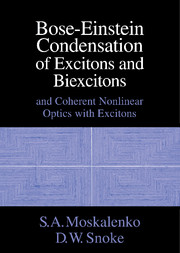Book contents
- Frontmatter
- Contents
- Preface
- 1 Introduction
- 2 Basic Theory of Bose–Einstein Condensation of Excitons
- 3 The Interaction of Condensed Excitons with Lattice Phonons
- 4 Bose–Einstein Condensation of Biexcitons
- 5 Phase Transitions and Thermodynamics of High-Density of Excitons
- 6 The Optical Stark Effect and the Virtual Bose Condensate
- 7 Bose–Einstein Condensation of Mixed States of Excitons and Photons
- 8 Nonequilibrium Kinetics of High-Density Excitons
- 9 Coherent Nonlinear Optics with Excitons
- 10 New Directions
- Appendix A: Properties of Excitons in Cu2O
- Author Index
- Subject Index
5 - Phase Transitions and Thermodynamics of High-Density of Excitons
Published online by Cambridge University Press: 04 August 2010
- Frontmatter
- Contents
- Preface
- 1 Introduction
- 2 Basic Theory of Bose–Einstein Condensation of Excitons
- 3 The Interaction of Condensed Excitons with Lattice Phonons
- 4 Bose–Einstein Condensation of Biexcitons
- 5 Phase Transitions and Thermodynamics of High-Density of Excitons
- 6 The Optical Stark Effect and the Virtual Bose Condensate
- 7 Bose–Einstein Condensation of Mixed States of Excitons and Photons
- 8 Nonequilibrium Kinetics of High-Density Excitons
- 9 Coherent Nonlinear Optics with Excitons
- 10 New Directions
- Appendix A: Properties of Excitons in Cu2O
- Author Index
- Subject Index
Summary
Introduction
As discussed briefly in Chapter 1, the general theory of phase transitions in the electronhole system predicts that in a system with a simple band structure, when annihilation and polariton effects are neglected, there will always be a region of phase space in which BEC of electron-hole pairs occurs. In this chapter we examine some of the more complicated features of the electron-hole phase diagram.
The many-body system of electrons and holes appears deceptively simple. If one neglects the possibility for electron-hole annihilation, one can consider the following apparently simple system: two types of Fermi particles with equal mass and opposite charge, interacting only by means of Coulomb interaction. As we will see in this chapter, however, the phase diagram for this system is extraordinarily complex, and the full theory for the phase diagram is not yet complete. We emphasize that most of these complexities arise solely from the above simple model and not from the other complicated features of solids such as band structure, band-to-band recombination, etc. Therefore much of this theory applies equally well to the case of electron-positron plasma or electron-ion plasma. The similarity of the e-h system to the electron-proton system, for example, suggested the existence of excitonic molecules [1,2] and, moreover, the possibility of a gas-liquid phase transition of exciton and biexciton gas into a Fermi electron-hole liquid (EHL). The EHL is the bound state of a macroscopically large number of electrons and holes [3-6], similar to the many-electron-proton system.
As stressed by Keldysh, however, this similarity is not complete. In a comprehensive and instructive review [7], he pointed out the peculiar properties distinguishing the e-h system from any other, which we summarize here.
- Type
- Chapter
- Information
- Bose-Einstein Condensation of Excitons and BiexcitonsAnd Coherent Nonlinear Optics with Excitons, pp. 166 - 200Publisher: Cambridge University PressPrint publication year: 2000



